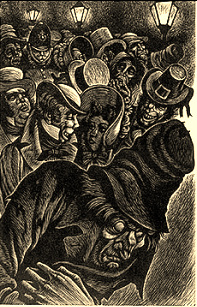The Man of the Crowd
Summary
The Man of the Crowd is Poe's short story that takes place in an unnamed coffee shop in London. As the narrator sits, he is fascinated by the crowd outside the window and wonders how isolated people think they are even though there is a "very denseness of the company around." The narrator then takes time to categorize the different types of people passing by. As evening approaches, the narrator's eye catches an old man passing. This man captivates the narrator's attention, and the narrator darts out of the coffee shop to follow the man from afar. The man leads the narrator from one shop to another, staying in the crowd of the people. The pursuit lasts through the night and into the next day. Exhausted from the chase, the narrator finally gives up, concluding that the man is "the type of genius of deep crime" due to his inability to leave the crowds of London.
Analysis
Edgar Allan Poe perceived a strong link between a person's internal being and his physical appearance. This is expressed through a number of his short stories including The Man of the Crowd and Ligeia. The most noticeable aspect of The Man of the Crowd is the narrator's use of physiognomical classification of the crowds below. He identifies the Jewish merchants by their "hawk eyes" and alcoholics by their "lack-luster eyes" as two examples. The narrator believes he can read a person's history in a mere glance of a person's face as they pass by. The narrator even goes beyond physical appearance when he makes a connection that the mind takes an active role in external characteristics such as clothing and accessories. The narrator identifies upper clerks by their "pantaloons of black or brown, made to fit comfortable" and aging women by their "bejeweled and pain-begrimed" appearance. Stereotyping groups of people like the narrator does is simply deductive reasoning. The narrator takes previously conceived views of people and uses them to make assumptions of a passerby. One reason the narrator may have stereotyped the people below is that it is too difficult to individualize people because of all the complexities (Lippmann). Even stereotyping people into large groups could not describe the old man that passed by the narrator's window. Intrigued, the narrator had to follow the old man so that the old man could be classified.
Conclusion
Stereotypes exist everywhere, and there is no use trying to escape them. None, though, are completely true for every person under that stereotype, but most stereotypes are intended to encompass almost an entire group. Through physical appearance alone, the narrator would not have been able to stereotype every person walking by, but by definition of stereotyping, he was able to classify some people. Physiognomy was the early stereotyping because observations had to be made about a group of people to find similarities between physical appearance and personality. There have always been critics of any science, and for physiognomy, a critic was Leonardo da Vinci(Physiognomy). He did not believe that physiognomy was true because there was no scientific foundation besides observation, but da Vinci did believe that lines cause d by facial expressions could indicate personality traits. Physiognomy became popular through the 18th and 19 century, influencing novelists and artists such as Balzac and Joseph Decreux. Phrenology, created around 1800, also became widely popular and influential as a form of physiognomy.
As proof that stereotyping is possible, a physiognomist named Yoshito Mizuno was employed by the Imperial Japanese Naval Aeronautics Department to predict the qualifications of candidates to become successful pilots. Through the work of physiognomy, Mizuno correctly predicted qualified candidates with over 80% accuracy(Vlasto). Though it can not be scientifically proven, there is evidence that there may be authenticity behind physiognomy and stereotyping.
As proof that stereotyping is possible, a physiognomist named Yoshito Mizuno was employed by the Imperial Japanese Naval Aeronautics Department to predict the qualifications of candidates to become successful pilots. Through the work of physiognomy, Mizuno correctly predicted qualified candidates with over 80% accuracy(Vlasto). Though it can not be scientifically proven, there is evidence that there may be authenticity behind physiognomy and stereotyping.

